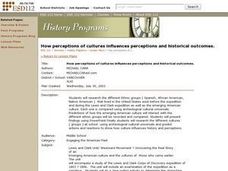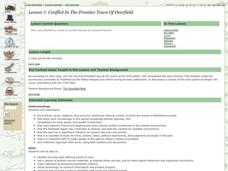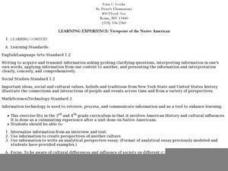Curated OER
William Apess and the Mashpee "Revolt" of 1833
Prompt your class with the following question: What was the status of American Indians in Massachusetts during Jackson's presidency? To answer this question, class members will read a series of primary source documents (attached),...
Curated OER
Native Americans and Native Plants
Students take a field trip to a native plant culture. They need to describe where the plants were before the Europeans occupied North America.
Curated OER
Lesson: Straight from the Horse's Mouth
Imagine life from a horse's perspective. That's what the class will be doing after they analyze images of the Crow installation piece, Horse Outfit. They analyze the cultural significance of the work, the tribe who created it, and then...
Center for History Education
Pontiac's War
Invaders are coming: fight them off or run? Native American peoples had to decide this question after British colonists went west following the French and Indian War. Using a speech from Chief Pontiac, young historians consider if they...
Curated OER
How Perceptions of Cultures Influences Perceptions and Historical Outcomes
Students research different ethnic groups that lived in the United States. They compare and contrast Spanish, African American and Native American cultures and how American culture interacted with them. They present their findings...
Curated OER
Native Lands: Indians in Georgia, How Do We Know What We Know?
Students examine Native American oral traditions. In this Georgia history lesson, students discuss Native American oral traditions and research stories of migration. Students create their own oral history projects that feature their...
Curated OER
Atlatl (Native Americans)
Students discover what an atlatl is and how to use it. In this Native American lesson, students discuss the history of the Native American atlatl and practice throwing with it. Students will analyze the effects of the atlatl in terms of...
Curated OER
James Welch's Fools Crow
Learners explore the history of Montana's Native Americans by reading James Welch's Fools Crow. Set shortly after the Civil War, the novel focuses on a young Blackfoot Indian and his tribe. Over the course of several weeks, class members...
Pace University
Jacksonian Democracy
Jacksonian Democracy ... a total success or a complete failure? Young academics examine Jacksonian Democracy, including the concept of the supremacy of the federal government and the forced relocation of Native Americans. Scholars...
Curated OER
A Historic Gamble
Students explore and evaluate the economic impact of legalized gambling on Native American Indian communities. They draft short, persuasive speeches that take the perspective of a tribal elder appearing at a town council meeting.
Curated OER
Conflict in the Frontier town of Deerfield
Learners use primary sources to investigate, explore and represent varying perspectives on the 1704 Deerfield Raid. They consider the reasons Deerfield was at the center of English, French and Native American conflicts in the early 18th...
Curated OER
The Treaty Trail: Examining an Artist's Perspective
Elementary school leanrners examine artwork from the time period of the United States and Native American treaties. They discuss the causes and effects of the treaties being signed. They also examine how cultural perspective influences art.
Curated OER
Indian Removal: Does History Always Reflect progress?
Students explore the idea that progress for some might not mean progress for all. In this Native American lesson, students recognize different viewpoints about historical events through the study of primary documents. Students decipher...
Curated OER
Direct Express
Although the game cards are not posted at this time, you could easily create some to put this plan into action. Simply write a few starting lines from different speeches on each index card, and have learners guess if the speaker's intent...
Curated OER
Fort Owen: Cultural Crossroad of the Bitterroot Valley
Fourth graders investigate the history of Bitterroot Valley. They conduct research using primary and secondary resources. The analysis of the information is used to discover the true relationship the settlers and native peoples. Then...
Curated OER
Native Americans - Searching for Knowledge and Understanding
Middle schoolers examine lives of Native Americans in order to become familiar with contributions to and influences on American society particularly, but not exclusively, in the Western region of the United States. Students focus on...
K20 LEARN
Manifest Destiny: U.S. Territorial Expansion
A close examination of John Gast's painting "American Progress" launches a study of the concept of Manifest Destiny used to justify United States' policy of westward expansion. Young historians read statements from persons with different...
Curated OER
Viewpoint of the Native American
Students compare how Native Americans were treated long ago to how they are treated today. They write an essay from the perspective of a Native American from their time period explaining their side with details supporting their views.
Curated OER
Interpreting Quotes from Native Americans and European Americans (1790s-1820s)
Young scholars examine the relationships between Native Americans and Europeans. Using the War of 1812, they analyze quotes of each group and discuss how they are connected to the war. They discover how each group viewed the same...
Curated OER
Lesson 6: Native Americans in the West
Learners recall their knowledge of Native American people who lived in the West and reflect on how their perspectives differed from pioneers and argonauts of the 19th century.
Curated OER
Native Americans
Young scholars, in groups, research various Native American tribes. They wirte a report about the tribe which includes information about their food and ceremonies, among other things. They create a diorama and a poster that shows how...
Curated OER
SIRS Discover: Native American Biographies
Fourth graders work in cooperative groups to select and evaluate appropriate magazine articles on Native Americans. They view the program SIRS Discoverer, complete activity sheets then perform oral presentations.
K20 LEARN
Allotment in Indian Territory: Land Openings in Indian Territory
To understand how the allotment policy embedded in the Dawes Act, passed by the U.S. government in 1887, affected the tribal sovereignty of Native Americans, young historians examine various maps and documents and Supreme Court cases...
Curated OER
Comparing Kwakiutl, Cheyenne and Navajo tribes
Third graders study the difference between the Kwakiutl, Cheyenne and Navajo tribes. They identify the people, resources, lifestyle and beliefs of the Kwakiutl, Cheyenne, and Navajo Indians. Afterward, they present their projects on each...

























